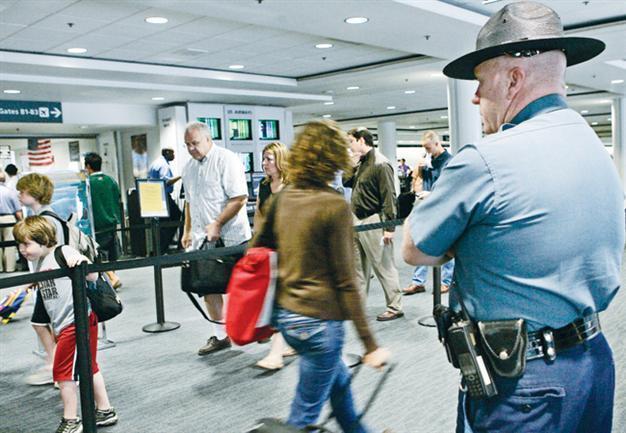US airlines tell what to wear
DALLAS

A state trooper keeps watch over travelers making their way through Logan International Airport in Boston in this file photo. Several US airlines refuse ticketed passengers boarding based on how they were dressed. AP photo
Discussion of recent, controversial decisions by airlines to refuse ticketed passengers boarding has flared up in the United States following multiple incidents where passengers were not allowed to board planes because of how they were dressed.
A woman flying from Las Vegas on Southwest Airlines this spring said she was confronted by an airline employee for showing too much cleavage. In another recent case, an American Airlines pilot lectured a passenger because her T-shirt bore a four-letter expletive. She was allowed to keep flying after draping a shawl over her shirt.
Both women told their stories to sympathetic bloggers, and the debate over what you can wear in the air went viral. Since airlines don’t publish dress codes there are no rules that spell out rules for the highest hemline or the lowest neckline allowed.
“It’s like any service business. If you run a family restaurant and somebody is swearing, you kindly ask them to leave,” said Kenneth Quinn, an aviation lawyer and former chief counsel at the U.S. Federal Aviation Administration. The American Airlines passenger, who works for an abortion provider, was singled out because her T-shirt had a pro-choice slogan.
A spokesman for the company said the passenger was asked to cover up “because of the F-word on the t-shirt,” according to the Associated Press. This incident was not the airline taking sides in the abortion debate, Quinn said. Last week, Arijit Guha, a graduate student from Arizona State University, was barred from a Delta flight in Buffalo, New York because of she was wearing a shirt that mocked federal security agents and included the words, “Terrists gonna kill us all.” He said the misspelled shirt was satirical and he wore it to protest what he considers racial profiling.
“I thought it was a very American idea to speak up and dissent when you think people’s rights are being violated,” Guha said. The pilot felt it might scare other passengers.
American and Delta are within their rights to make passengers change shirts even if the messages are political, said Joe Larsen, a First Amendment lawyer from Houston who has defended many media companies.
The First Amendment prohibits the government from limiting a person’s free-speech rights, but it doesn’t apply to rules set by private companies, Larsen said.
In short, since airlines and their planes are private property and not public spaces, such as a courthouse’s steps, flight crews can tell you what to wear.
In the early years of jet travel, passengers dressed to the nines for air travel and confrontations over clothing were unimaginable. Though there aren’t any precise numbers they’re still rare, but when showdowns happen, they gain more attention as aggrieved passengers complain on the Internet about airline clothing cops. It’s unwelcome publicity for airlines, which already rate near the bottom of all industries when it comes to customer satisfaction.
Critics complain that airlines enforce clothing standards inconsistently. The lack of clear rules leaves decisions to the judgment of individual airline employees. US Airways spokesman John McDonald said the airline doesn’t have a dress code, but that employees may talk to a passenger if other people might be offended by the way he’s dressed. “It’s not an issue of a dress code, it’s one of disruption, like watching pornography within sight of other passengers,” McDonald said.
